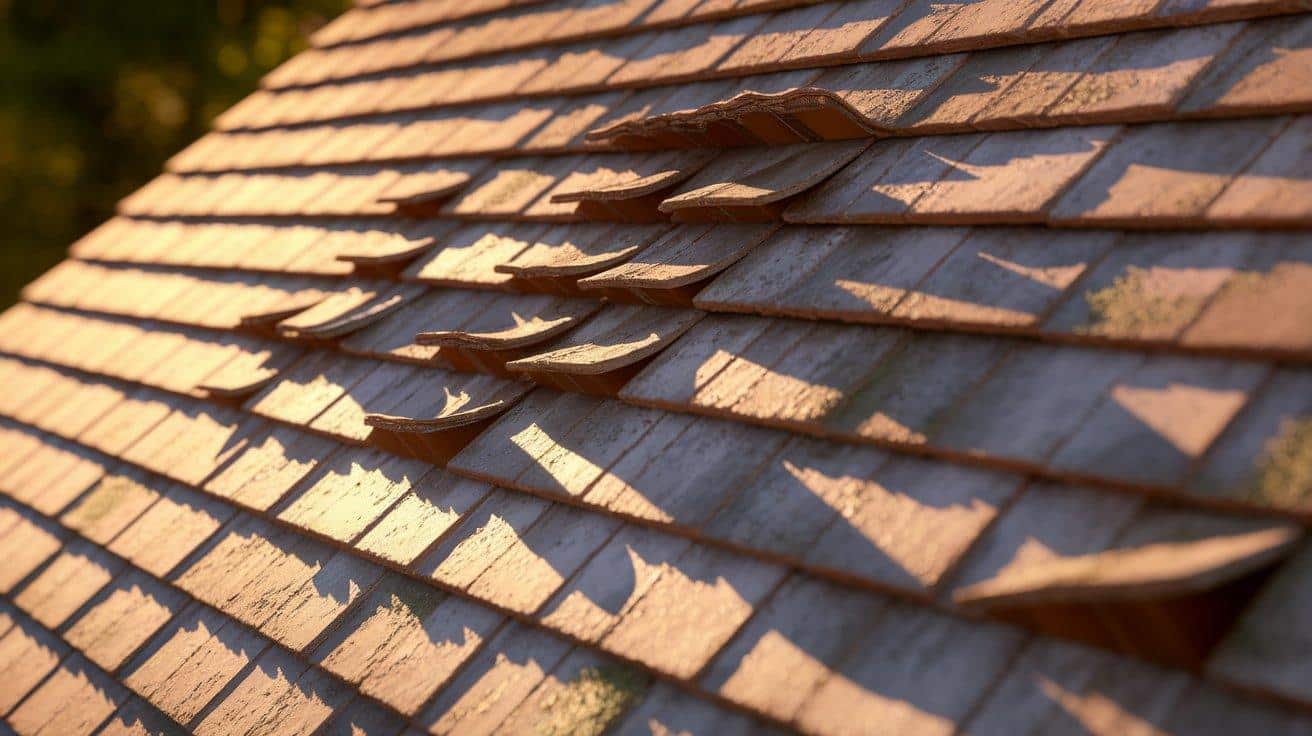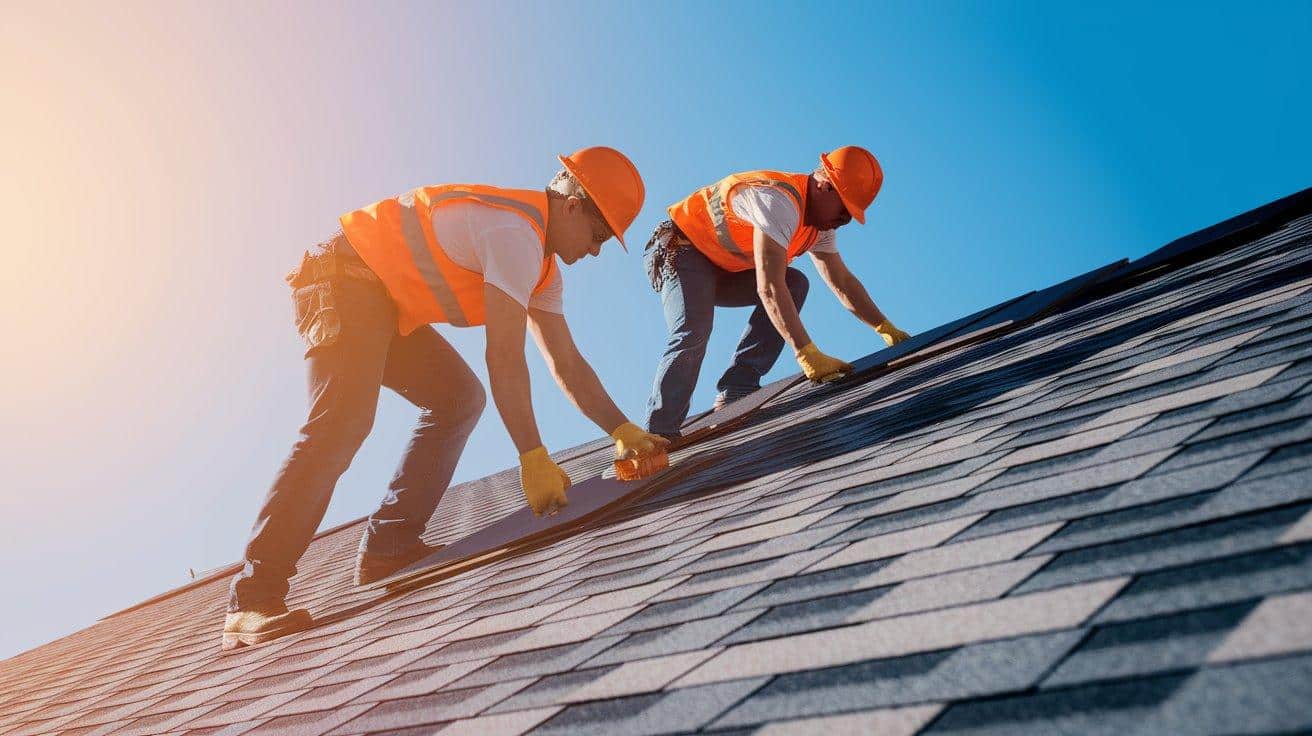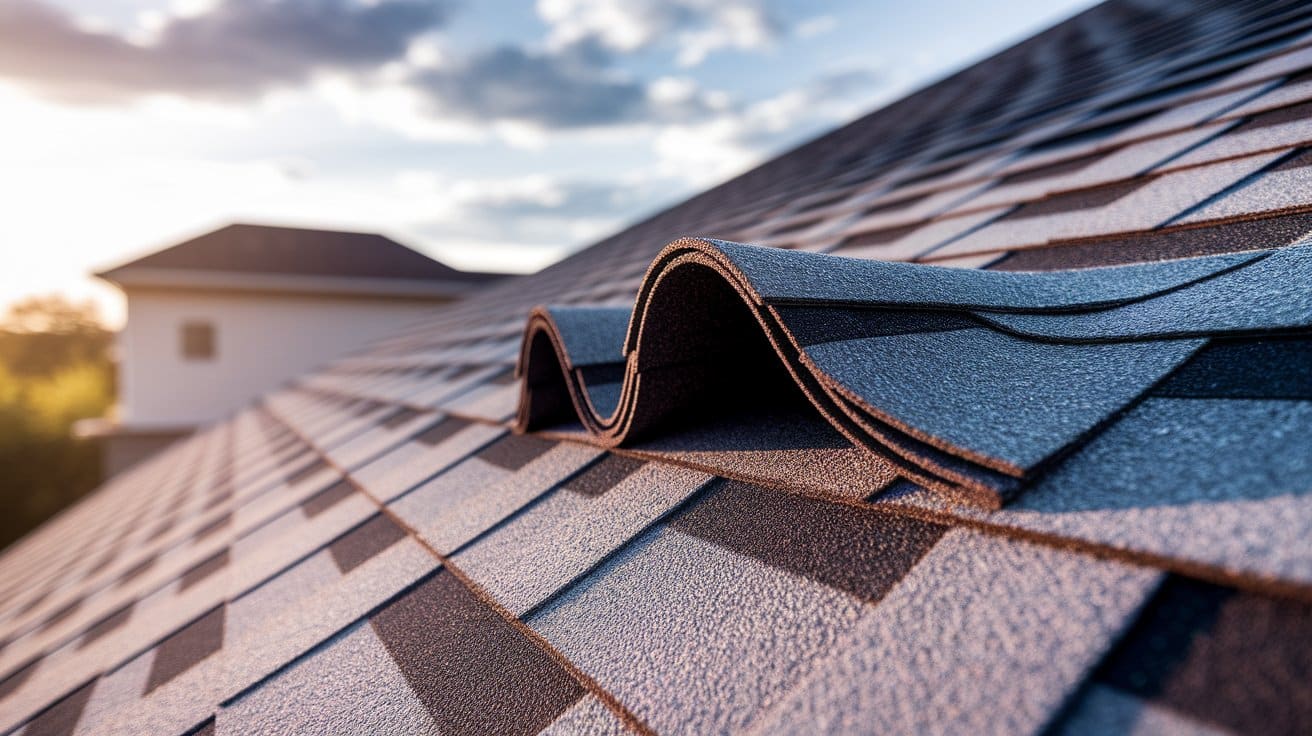Do you stare at those uneven spots on your new roof with growing concern?
I understand your frustration. Flat, properly seated shingles keep water out and your home protected. But when they start lifting, buckling, or curling, trouble might follow.
I know finding bumps or waves in your fresh roof can feel discouraging after spending money on home improvements. Your roof should be smooth, straight, and secure.
Many homeowners worry when they see uneven shingles. Is it normal? Will it fix itself? Could it lead to water damage? These are valid questions that need answers.
Let me show you why this happens and what can be done. By the end of this blog, you’ll know if your roof needs quick action or simply time to settle in properly.
What is Roof Shingles?
Roof shingles are flat, rectangular pieces that overlap to form your roof’s outer layer. They work as your home’s first defense against rain, snow, and sun.
Most homes in the US use asphalt shingles. These contain a base mat coated with asphalt and topped with mineral granules. The granules give color and protect against UV rays.
Other types include:
- Wood shingles – made from cedar, redwood, or pine
- Metal shingles – steel, aluminum, or copper pieces
- Slate shingles – natural stone cut into thin layers
- Composite shingles – made from recycled materials
Good shingles should lay flat against your roof. This creates a tight seal that stops water from getting under them. When properly installed, they form straight, even lines across your roof.
What Does It Mean When Shingles Don’t Lay Flat?

When roof shingles fail to lay flat, it points to issues that might affect your home’s protection. Properly installed shingles form a smooth, uniform surface that directs water away from your home.
Uneven or lifted shingles can allow water to seep underneath. This might lead to leaks, deck damage, and mold growth inside your attic. The visual bumps or waves you see from the ground signal potential trouble above.
Beyond water damage, uneven shingles catch more wind. This makes them prone to blowing off during storms. Raised edges also collect leaves and debris, which hold moisture against your roof.
Most manufacturers may void warranties if shingles aren’t properly sealed. This makes fixing the issue promptly very important for long-term protection.
What’s Normal After a Fresh Shingle Installation?
After a new installation, some temporary unevenness is normal. Fresh shingles need time to “set” and conform to your roof.
Initial settling period:
- New shingles may appear slightly raised or curled at first
- The sun’s heat helps activate the self-sealing strips
- Normal settling takes about 2-3 weeks in warm weather
- Full bonding often requires several days of sun exposure
During cooler months, this process takes longer. The adhesive strips need warmth to bond properly. Shingles installed during fall or winter might not fully seal until spring brings warmer days.
How can you tell if it’s normal settling or an actual problem?
Watch for these signs:
- Issues that worsen rather than improve over time
- Only certain sections showing problems while others lay flat
- Persistent lifting after a full month of warm weather
What Causes Your New Shingles to Lift or Curl?
Several factors can cause your new shingles to lift or curl instead of laying flat. Understanding these causes helps you address the real issues behind the problem.
| Category | Common Causes |
|---|---|
| Installation Issues | Incorrect nail placement, nails driven too deep, nails not driven deep enough, missing starter strips, improper shingle alignment |
| Weather Factors | Cold shingles becoming stiff during installation, slow activation of sealing strips below 50°F, trapped moisture between layers, wet decking warping as it dries |
| Structural Problems | Warped or rotted plywood, old water damage on the roof base, sagging rafters creating dips, poor attic ventilation causing heat buildup |
| Material Quality | Lower-cost shingles with thin materials, budget brands with less effective sealants, factory defects, improper storage before installation |
What You Should Do About Lifting New Shingles?
New shingle installations might need time to settle, but persistent lifting requires attention. Your response should depend on how long the shingles have been installed and the severity of the issue.
For Recent Installations
- Take photos to document the condition
- Wait for warm weather to allow sealing
- Monitor changes over 2-3 weeks
For Ongoing Problems
- Contact your roofing contractor
- Check your warranty coverage
- Request a professional inspection
Warning Signs Needing Immediate Action
- Increased lifting during the wind
- Water stains on ceilings
- Granules collecting in gutters
- Problems that worsen over time
How to Prevent Shingle Problems in Future Roofing Projects?

Planning ahead can save you from dealing with uneven shingles in the future. Prevention starts well before the first shingle goes on your roof.
For your next roofing project:
- Choose certified contractors with proven experience
- Select quality materials from well-known manufacturers
- Schedule installation during moderate weather (50-85°F)
- Request a complete tear-off rather than roofing over old shingles
- Ensure proper deck inspection and repair before installation
- Verify that proper ventilation will be installed or maintained
- Get all warranty details in writing before work begins
Ask potential contractors about their quality control process and how they ensure proper nail placement. The small details during installation make a big difference in how your roof performs over time.
How Poor Ventilation Can Warp Your Roof?
Your attic’s airflow directly affects how your shingles perform. Poor ventilation creates heat and moisture issues that damage shingles from beneath.
When hot air gets trapped in your attic, temperatures can reach 150°F or higher. This excessive heat cooks your shingles from below, making them brittle and prone to curling. In winter, trapped moisture freezes and thaws repeatedly, pushing against the underside of shingles.
Signs of ventilation problems include:
- Curling shingles are concentrated near the roof peak
- Higher energy bills from overworked air conditioning
- Visible mold or moisture in the attic
- Ice dams form along roof edges in winter
A properly ventilated roof needs both intake vents (usually in the soffits) and exhaust vents (at the ridge or through vents). This creates a continuous airflow that helps maintain consistent temperatures and removes moisture.
How to Safely Monitor Shingle Issues from Ground Level?
You don’t need to climb on your roof to keep track of shingle problems. Safe monitoring from the ground helps you catch issues early.
Use these simple techniques:
- Stand at different angles around your home with binoculars
- Take clear photos with a zoom lens to document changes over time
- Look after rainstorms for signs of water damage
- Check your gutters for excessive granule loss
- Examine your attic ceiling for water stains or light showing through
Create a simple roof monitoring schedule—check after major storms and once each season. Compare current photos with previous ones to spot new issues or track existing problems.
If you notice sudden changes or worsening conditions, contact a professional. Never attempt to walk on the roof yourself, as this can be dangerous and might damage the shingles further.
Shingle Sealant Technology and Its Limitations
Modern shingles include self-sealing strips that create tight bonds between layers when activated by the sun’s heat. This technology helps resist wind and water penetration, but works within specific conditions.
The sealant needs temperatures above 70°F and several days of warmth to properly activate. Cool weather installations may not seal until the following warm season. This explains why many winter installations show temporary lifting until spring arrives.
- Activates only with sufficient sun exposure and heat
- Requires clean contact surfaces free of dust and debris
- Varies in strength between economy and premium products
- May need manual sealing in certain weather conditions
Even the best sealant technology has limits. Heavy wind can break these bonds, especially on shingles facing prevailing wind directions. Age naturally reduces sealant effectiveness, which is why older roofs often show more lifting than newer ones.
Long-Term Maintenance Tips to Keep Shingles Flat and Secure
Regular maintenance helps your shingles stay flat and secure throughout their lifespan:
- Clear leaves and debris from the roof and gutters seasonally
- Trim tree branches that hang over the roof
- Remove moss or algae growth before it spreads
- Schedule professional roof inspections every 2-3 years
- Repair loose or damaged shingles promptly
- Minimize foot traffic on your roof to prevent seal breaks
- Check your attic for leak signs after a major storm
Conclusion
Uneven shingles on a new roof can worry any homeowner. Now you understand what causes this common problem and how to handle it.
Some unevenness is normal during the first few weeks after installation as shingles need time and warm weather to seal properly. However, if problems persist, they likely point to installation issues, material quality, or underlying structural problems.
Keep an eye on your roof, document any changes, and don’t hesitate to contact your contractor if issues continue. Most problems are covered under warranty if addressed promptly.
With proper installation, quality materials, and regular maintenance, your roof should provide years of flat, secure protection for your home.
Frequently Asked Questions
Can I Use a Hair Dryer to Help Seal Lifted Shingles?
No, this may damage shingles. Only natural sunlight provides the right heat level for proper sealing without causing harm.
Are Certain Roof Pitches More Prone to Shingle Lifting?
Yes, steep roofs experience less lifting as gravity helps shingles lay flat, while very low-slope roofs see more issues.
How Soon After Installation Can I Install Roof Accessories Like Solar Panels?
Wait at least one month for shingles to fully set before adding any roof fixtures or panels.


